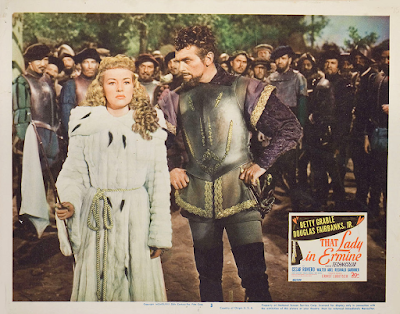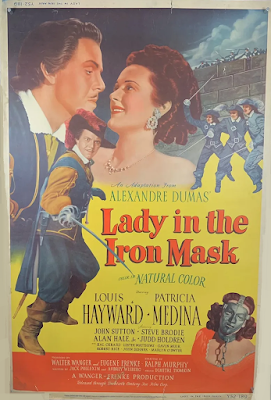Wonderland Burlesque's
Let's All Go To The Movies:
She's A Lady!
Part V
Sometimes? It takes a lady.
Or so these films would have us believe.
They promise lots of drama, the occasional comedy or musical, and lots of dirt!
Let's take a walk down Hollywood Blvd. and shine a light on these magnificent classic films.
This way, if you please. But remember...
Ladies first!
Or so these films would have us believe.
They promise lots of drama, the occasional comedy or musical, and lots of dirt!
Let's take a walk down Hollywood Blvd. and shine a light on these magnificent classic films.
This way, if you please. But remember...
Ladies first!
--- ---
Lady In The Dark
(1944)
Liza Elliott, Allure magazines editor-in-chief, suffers from headaches and continuous daydreams. She undergoes psychoanalysis to determine why.
Based on the 1941 musical of the same name by Moss Hart, this American musical was directed by Mitchell Leisen, from a screenplay by Frances Goodrich and Albert Hackett. It stars Ginger Rogers, Ray Milland, Warner Baxter, and Jon Hall.
Paramount paid $285,000 for the film rights to the stage hit, a record at the time. $115,000 to producer Sam Harris, $85,000 to librettist Moss Hart and $42,500 each to composer Kurt Weill and lyricist Ira Gershwin. Gertrude Lawrence, Victor Mature and Danny Kaye were in the original cast.
Gertrude Lawrence was offered the opportunity to do a screen test for the role she had created on Broadway. She found the notion undignified and refused.
Mary Phillips who plays Ginger Rogers' side kick Maggie was once married to Humphrey Bogart when her career on Broadway was booming and his in Hollywood was not.
Paramount paid $285,000 for the film rights to the stage hit, a record at the time. $115,000 to producer Sam Harris, $85,000 to librettist Moss Hart and $42,500 each to composer Kurt Weill and lyricist Ira Gershwin. Gertrude Lawrence, Victor Mature and Danny Kaye were in the original cast.
Gertrude Lawrence was offered the opportunity to do a screen test for the role she had created on Broadway. She found the notion undignified and refused.
The faraway song from Liza's childhood that she can't recall is the Kurt Weill-Ira Gershwin classic My Ship. Gershwin was appalled when he saw that only a fragment of the song was sung in the film (four bars rendered a cappella by Marjean Neville, who portrayed Liza as a child). In the stage version, the song was sung to completion at the show's conclusion by Liza, and both director Mitchell Leisen and Ginger Rogers reported that Rogers had pre-recorded a lovely rendition of the tune. In his memoirs, Leisen ended the mystery as to why My Ship and nearly all of the show's score had been jettisoned for the film version: Paramount studio chief Buddy DeSylva apparently despised Weill's music and was determined to delete as much of it as possible! Fortunately, Moss Hart's play is so sturdy that the film was able to withstand the shearing of its score.
Costume designer Edith Head is credited for Ginger Rogers' modern day dress in the film. Broadway-film couturier/set designer Raoul Pene du Bois is credited as the costume/set designer for the circus dream sequences. Paramount film studio art department supervisor Hans Drier served as the film's Production Designer. The film's director Mitchell Leisen, (formerly a set and costume designer), supervised and contributed his imaginative set and costume ideas in the creation of the film's scenery and costumes
Leisen was instrumental in creating the mink-fur skirted gown lined in jewels for Ginger Rogers' musical circus sequence. Raoul Pene du Bois designed this costume which is typically attributed to the film's lead costumer Edith Head. The first mink gown was created, and during fittings and rehearsals it was discovered that the fur-lined bejeweled costume was simply too heavy for Ginger Rogers to walk or stand in during long filming sequences, let alone dance and perform. The first original gown, lined with matched paste-glass rubies and emeralds, cost $35,000 to manufacture. Photos of Rogers in the fur skirted paste-jeweled gown do exist.
The New York costume wizard Barbara Karinska was at the cross town - Culver City MGM studio collaborating with the costume designer Irene on the Ronald Colman/Marlene Dietrich film version of Kismet. Raoul Pene du Bois, who had collaborated with Karinska in New York, begged Madam Karinska to remake the fur skirt so Ginger Rogers could perform and dance. Karinska made a second version of the mink dress, lined with sequins instead of paste jewels. She then turned to the studio costume department, which maintained a fur vault providing fur pelts for coats and costume trimming. Karinska built a wire hoop covered with a fine netting, hanging and spacing the mink pelts apart from each other; supported by net, reducing the number of mink pelts on the skirt and it's total weight. This allowed the skirt flexibility on the actress' body during the dance sequence.
Both gowns are shown in the movie. The original fur-skirted gown with the paste-glass jewels was donated to the Smithsonian Institution. The second fur skirted gown was de-constructed, with the fur pelts returned to the studio's fur vault. Karinska was never received any credited for her work on the gown.
Lady In The Lake
(1947)
A detective is hired to find a publisher's wife who is supposed to have run off to Mexico. But the case soon becomes much more complicated when people start getting murdered!

Adapted from Raymond Chandler's 1946 book of the same name, this American film noir was directed by Robert Montgomery and stars Montgomery, Audrey Totter, Lloyd Nolan, Tom Tully, Leon Ames and Jayne Meadows.
According to Robert Montgomery, he had a little trouble making the picture because nobody seemed to want an actor who wanted to also direct. Audrey Totter once said in a interview that, given the odd filming method, it was easy for her to play her role, due to having done work on radio.
Rumored to have been intended as a December 1946 release, which would have complimented the Christmas-themed aspects of the film, MGM executives backed down at the last minute and delayed its release until January 1947 so as not to offend holiday season moviegoers, a high percentage of which included the so-called 'family trade'. For the same reason, they tacked on a 'happy ending' sequence, over the strenuous objections of both Montgomery and Totter. Both these decisions hamperd the film's box office and critical reception.
This American Technicolor musical was directed by Ernst Lubitsch (and Otto Preminger) and stars Betty Grable, and Douglas Fairbanks, Jr. The screenplay, by Samson Raphaelson, is based on the 1919 operetta Die Frau im Hermelin by Rudolph Schanzer and Ernst Welisch.
In 1942, the studio announced Irene Dunne would star in the dual roles of Angelina and Francesca, and a few months later, Charles Boyer was announced as her co-star, but nothing came of the project.
When Ernst Lubitsch became involved, he initially wanted Jeanette MacDonald for the female lead, although Fox production chief Darryl F. Zanuck preferred Gene Tierney, opposite either Cornel Wilde or Rex Harrison.
Although Lubitsch received sole credit as director, he died of a heart attack after only eight days of filming, and the project was completed by Otto Preminger. Preminger, who had completed A Royal Scandal when Lubitsch was forced to withdraw due to illness in 1944, took over the reins. He stipulated sole screen credit should go to Lubitsch "as a mark of respect and admiration for the departed master".
Douglas Fairbanks Jr. thought that Otto Preminger "ruined everything. No sense of humor, no fun, everything light in the script was squeezed out. It just wrecked my [career] momentum, just wrecked it."
In later years, Betty Grable said it was her least favorite of all her movies. It proved a turning-point in her career. She simply hated doing the film.
The movie turned out to be a box-office flop. On its initial release it grossed only about $1.5 million. It cost nearly $2.5 million to make.
The cast included Reginald Gardiner and Virginia Campbell, but an error on the movie poster (see the first movie poster) mistakenly credits 'Virginia Gardiner'.
The Lady In The Iron Mask
(1952)
This American adventure film was directed by Ralph Murphy, produced by Walter Wanger, and stars Louis Hayward, Patricia Medina. Alan Hale, Judd Holdren, and Steve Brodie.
Actress Barbara Payton was fired by producer Walter Wanger a week before the film was scheduled to go into production, being replaced by Patricia Medina. A party-girl with a reputation (she had affairs with Howard Hughes and a very-married Bob Hope) Payton was placed on suspension by Warner Bros. due to a physical altercation (an all the tabloid headlines it created) between her, Franchot Tone and Tom Neal. That suspension cost her this movie.
Louis Hayward had played the dual role of the imprisoned prince and his twin in the 1939 version The Man in the Iron Mask while Alan Hale, Sr. portrayed the same part in that film that his lookalike son Alan Hale, Jr. would play in this film thirteen years later.
Lady In Cement
(1968)
A sequel to the 1967 film Tony Rome, which also starred Frank Sinatra, this American neo-noir mystery crime comedy thriller was directed by Gordon Douglas and stars Frank Sinatra, Raquel Welch, Dan Blocker, Richard Conte, Martin Gabel, Lainie Kazan, and Pat Henry. It was based on the 1961 novel of the same name by Marvin H. Albert.
Following the success of Tony Rome, Aaron Rosenberg hired Marvin Albert to adapt the novel Lady In Cement for Sinatra. While waiting for the film to begin production, Sinatra starred in the film The Detective (1968).
The trauma of divorcing his young wife Mia Farrow hit Frank Sinatra hard early in 1968. He was filming this movie in Florida during the day while performing a stage show at the Fontainebleau at night. Refusing to do more than one take, and ripping out handfuls of the script to save time, Sinatra allegedly treated director Gordon Douglas like a lackey who was on the film simply to accommodate the actor's needs. Sinatra further insisted that Douglas schedule his scenes so that he never had to come to work before noon. In addition, Sinatra demanded that the sets be pre-lit, and for his stand-in to have plotted every move so that by the time Sinatra arrived he could complete action on one set and proceed to the next without delay. This was the fifth film he made with Douglas as his director - and it was, unsurprisingly, also the last!
The Saga Of Jenny - Ginger Rogers
from the 1944 movie musical Lady In The Dark.























































































































3 comments:
Grable ---- Wasn't she the original Sweater Girl?
Ginger had LEGS, hunny!
And Frank Sinatra and Raquel Welch? I have got to watch that. Raquel was stunning.
XOXO
Personnages des grandes dames interprtétés par les grandes dames du cinéma d’Hollywood.
-Beau Mec
Post a Comment